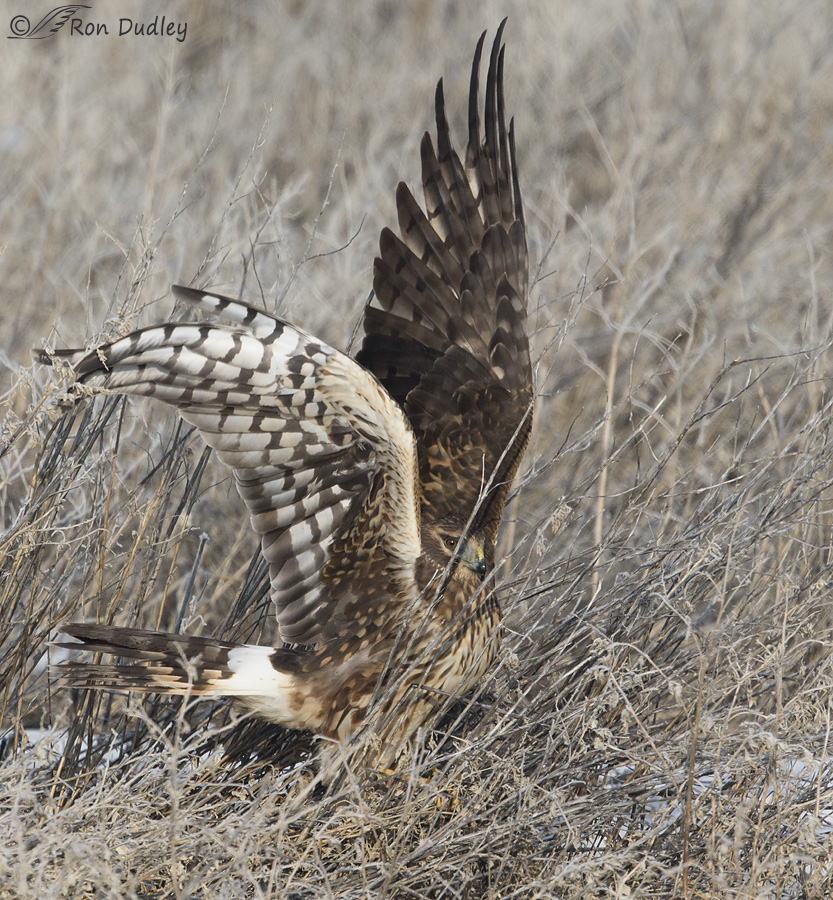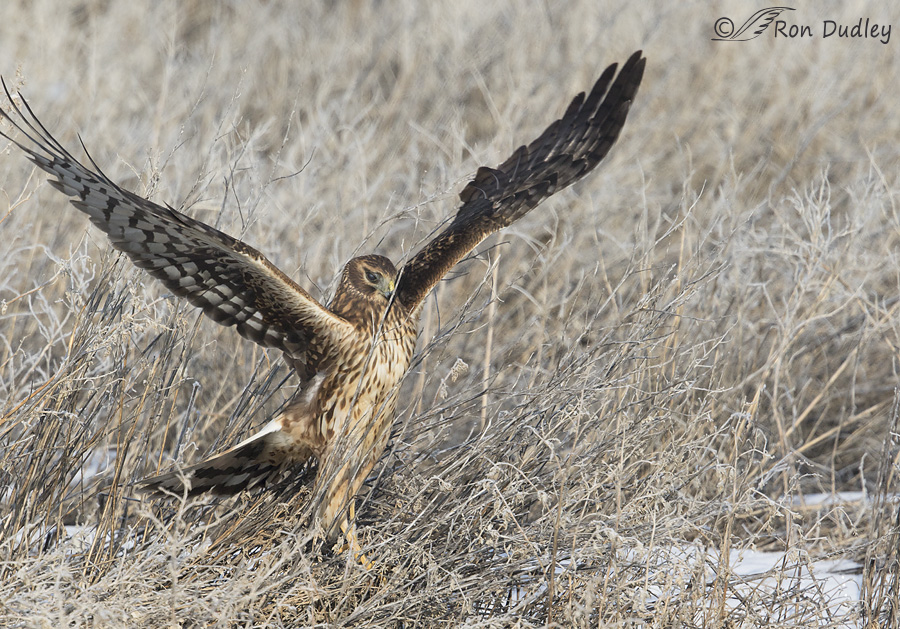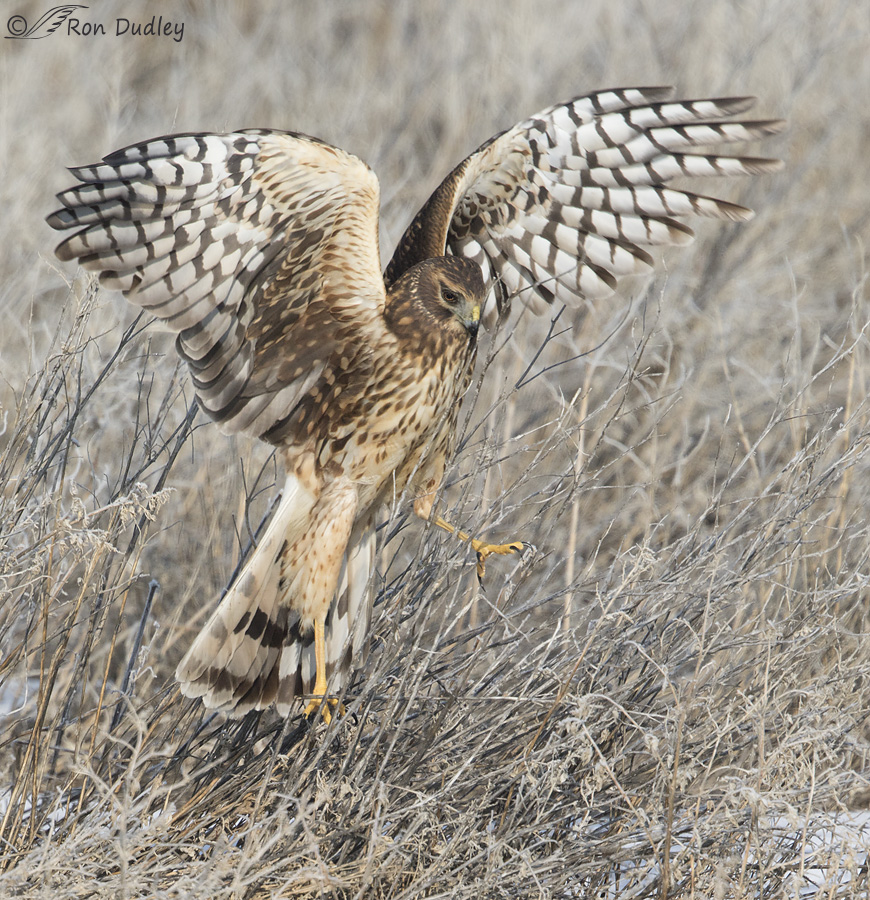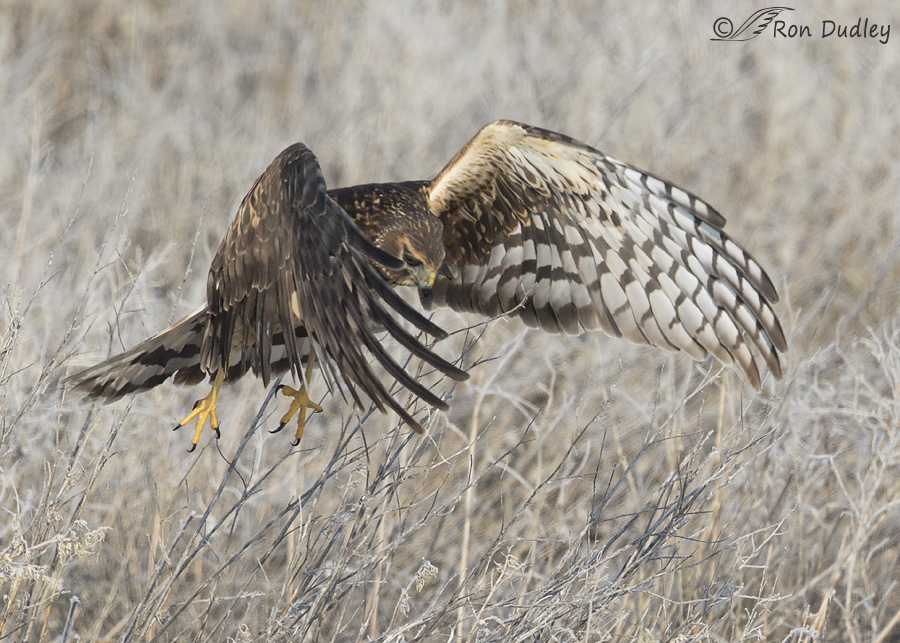Northern Harriers often dive into thick vegetation after prey. Getting out of there can be tricky.

1/2500, f/8, ISO 400, Canon 7D Mark II, Canon EF 500mm f/4L IS II USM + EF 1.4 III Extender, not baited, set up or called in
Yesterday morning at Farmington I saw this harrier dive on prey in the thick brush and then watched through my lens as it was consumed. I couldn’t tell for sure what it was but I’m pretty confident it was a vole. Then the bird cleaned its beak and walked a foot or two to a slightly more open area in preparation for takeoff. But takeoff was going to be a challenge given all the vegetation and those very long wings.
The more vertical the takeoff could be the better so the hawk squatted down to push straight up with its legs and raised its wings high over its body in preparation for the first down stroke meant to lift its body as vertically as possible. There were so many obstructing stems that some of the flight feathers in its right wing were momentarily caught in the vegetation and bent fairly dramatically as it was raised.

1/2500, f/8, ISO 400, Canon 7D Mark II, Canon EF 500mm f/4L IS II USM + EF 1.4 III Extender, not baited, set up or called in
As the wings began their first down stroke the hawk pushed straight up with its legs and as a result this photo caught the hawk on its tippy-toes.

1/2500, f/8, ISO 400, Canon 7D Mark II, Canon EF 500mm f/4L IS II USM + EF 1.4 III Extender, not baited, set up or called in
As vertically as this bird tried to take off it still had some forward momentum which placed vegetation directly in its path and those stems had to be dealt with. So the hawk used its feet in lightning-quick movements to grasp and push off of some of the stems which accomplished two things: it pushed some of the stems out of the way and it allowed the bird to gain additional elevation.
This is my favorite image of the series.

1/2500, f/8, ISO 400, Canon 7D Mark II, Canon EF 500mm f/4L IS II USM + EF 1.4 III Extender, not baited, set up or called in
As it began to clear the vegetation the hawk was still looking down at possible obstructions in its path – at this point they’d typically be looking forward. That head position prevented me from getting eye contact or a catch light in many of these and several other photos of the takeoff.
As raptors negotiate obstructions in their flight path at takeoff I often wonder how much of it might be planned and how much is due simply to incredibly fast reflexes. That’s a question I’ve posed before on my blog with a Red-tailed Hawk taking off from deep within a tree cluttered with obstructing branches. Before that bird took off it appeared? to be planning its escape route.
I wish I knew the answer but it’s interesting to speculate about. Personally I think they do plan ahead but to what degree I just don’t know. I suspect it varies from species to species and even among individuals of the same species – just like humans.
Ron


I really like the last shot: it grew on me more and more as I looked at it.
The day before yesterday I saw a kestrel at a park near my home. I’ve been to that park probably about a thousand times (I’m not kidding), and never once seen a kestrel there. But in the maybe half hour I watched it I got to see it dive into the tall grass (we had some rains recently) and wrestle with it’s prey. Sometimes only it’s tiny head would peek up out of the tumbleweeds and grasses, or its wings would be splayed out across the ground as it practically tumbled over with it’s prey. It caught two little mice, and I saw it eat every bit of them. Then today I saw another one near my school on a power post, and the first thing I thought was “kingbird? dove? kestrel!”, which is exactly what I thought at first yesterday. Odd, because I usually don’t see them around here… I’ve seen a hawk with a mouse, but this is the first time I’ve seen a raptor hunt and eat.
Ron,
Really nice series. It all happens so quickly I’m not sure anyone could figure it out… but you.
Stephen Clayson
I’m not sure how accurately I “figured it out” but I do my best. Stephen. I believe I’m at least very close…
Nice capture. Mallards will shoot straight up like that too, I think black ducks also share that ability, it’s been too long since I have been in the marsh.
Thank you, Ron.
Just love these shots. I’m a major fan of your behavioral series and that it’s a Harrier is all the better. They’re such fancy fliers. Sorry I’m late to the party today. I started out early and got distracted with home buying paperwork. DARGH!
Thanks, Laura. Hope you love your new home.
Fun series, I enjoy the second shot. It reminds me of a gymnast after a dismount.
I will never forget the hawk that came into the rehab with a sunflower stalk wound tightly around it’s wing. No breaks just soft tissue damage and probably self esteem.
Wow, that must have been a very unusual incident, April. The life of a raptor is fraught with unexpected peril.
Fascinating series. Such beautiful markings on the ventral surface of the wings. I’m amazed yet again by the agility and ingenuity of our feathered friends.
Thank you, Marty.
Late to the party, and echoing everyone else.
An amazing series. And of course they plan. Despite the benefits of incredibly fast reflexes. Some (like us) more successfully than others.
Thanks, EC. I don’t think there’s any question that they plan, at least to some extent. I just wish I knew to what degree.
Great series. Thanks for sharing. I have had the pleasure of watching a Northern Harrier hunt. One came very close to me. Unfortunately, the only time I’ve seen it dive after prey, it was too far away. Still, it was exciting to see.
“it was exciting to see”
It nearly always is, Marlo. Their incredibly quick and acrobatic aerial maneuvers as they dive on prey are impressive.
Wonderful series. The third shot just blew me away. Given the intelligence of raptors, I would be really surprised if they didn’t plan their route out of a situation.
That third photo is my favorite too, Susan – there’s no body parts clipped and there’s some color in the eye even though there’s no catch light. But I especially like the pose as it “climbs” up that vegetation at lightning speed.
A wonderful series! I’ve often wondered how these big birds negotiate in crowded, cluttered habitat, like bushes, deep grass, and tightly woven branches,especially given their wide wing spans…
Thank you, Patty, In the case of many of them, harriers especially, it’s because that’s where their prey often is.
It’s how not why that I wonder about…how they manuver so well after prey in those conditions with such wingvspans….
Sorry, Patty. You made that clear. I just misread it…
And it’s still a mystery and a wonder…another mystery, another wonder…nature is so darned chock full of them!!!
This is a beautiful series, terrific shots!
Thick vegetation, long wings tough to negotiate.
I have watched our Red-tail amongst branches put its wings over its head and push itself into the open before the down beat. I have always wondered how often birds in tough situations experiment or learn from experience. A thought process? Instinct? Or innate ability with experience to figure what works. Very interesting topic.
It’s fun to think about, isn’t it, Dick? Especially after you’ve watched one of them “perform” for you.
I’d bet all of them…why not? Instinct, planning, strategy, experience….even some of the “lowest” creatures can learn to negotiate a maze…
Very nice series, Ron. One would expect the nictitating membrane to deploy in that situation and it appears to be doing so in one image. Cool.
Cheers,
Dick
ID tip: “A funny bird is the harrier, it has white upon its derrière”.
Yes, the membrane is closed in that second shot, Dick.
Love your little ID trick. Bet you use that in the classes you teach…
Super Cool Ron !! Super Cool
Thank you, Jeffrey. Don’t know why it took so long for your comment to post…
I appreciate so much the very close look at anatomy–at all different angles and positions-that your photographs yield ! Every morning, an education AND beauty–what a combo !
Well, I’m not sure about “every” morning but I do try, Kris. Thank you.
So far it’s been “every morning” for me—and that’s been a few years now…amazing!!!
Patty, I just checked. You made your first comment on May 16, 2013 on my post titled “A Guide To Aging Bald Eagles”.
I think I may have been watching, not commenting, a little earlier…not sure…am bad with time…or anything else involving numbers….
Beautiful my favorite bird of all!!!!!! Everytime I see one it’s moving!! Fast!!!Oppurtunities to photograph them are extremely challenging and rare. Did you get my email yesterday about perches ?
No question about it, Marina – harriers are usually very difficult subjects. They can be a little easier this time of year around here.
Yes, I got it. You didn’t ask me any questions and I just ran out of time…
A super fantastic sharp, detailed and well documented series Ron. I love this kind of interpretive action/behavioural shots.
“I love this kind of interpretive action/behavioural shots”
So do I, Hank. It’s one of the primary focuses of my blog. Thanks very much.
Beautiful photos Ron. I wonder if this is why the British navy named their vertical take off jet the “Harrier”? If you talk to superb human athletes about whether they plan what they do in competition, most have trouble saying for sure how much is planned and how much is those lightning fast reflexes. Thanks for showing us the actual take off. Loved it.
Porcupine
Porcupine, It’s my understanding that the VTO Harrier “jump jet” was named both for the bird and the word “harry” which means to “persistently harass an enemy”. The hunting style of the harrier (bird) is very similar to the atttack style the jump jet is capable of.
My vanity license plates read “HARRIER” (see the graphic at the top of my blog). Folks at places like gas stations often ask me if I’m a Harrier pilot, though they usually say “retired” Harrier pilot…
Ron, are you familiar with the study the Air Force did many years ago to find out what age group has the fastest reflexes? Turns out fifteen year olds have the best physical qualifications to fly jets, but they make terrible decisions! Age has a few benefits, and it beats the alternative.
Porcupine
No, I wasn’t familiar with it but I believe it – both aspects of it. After 33 years in the high school classroom I can attest to that aspect of their decision making. At that age I had the same problem. It’s a miracle I survived some of my stupid adolescent hijinks and I wasn’t as bad as some of my friends were…
Nice series Ron! You are teaching me to look for details I have never comprehended before. Thanks!
Good, Robert. That’s nice to know!
Wonderful set!
Thanks, Judy.
Beautiful! I’m guessing part is learned, part is ingrained. Whatever it is it certainly makes for some magnificent photos and serves the harrier well.
Harriers are always great photo subjects, Judy. Challenging ones too!
Magnificent series Ron!
Charlotte
Thanks, Charlotte.
Beautiful action series! I don’t think planning and “incredibly fast reflexes” are necessarily an either/or situation!
Neither do I, Sallie. That’s why I said “how much of it” might be one or the other. Thank you.